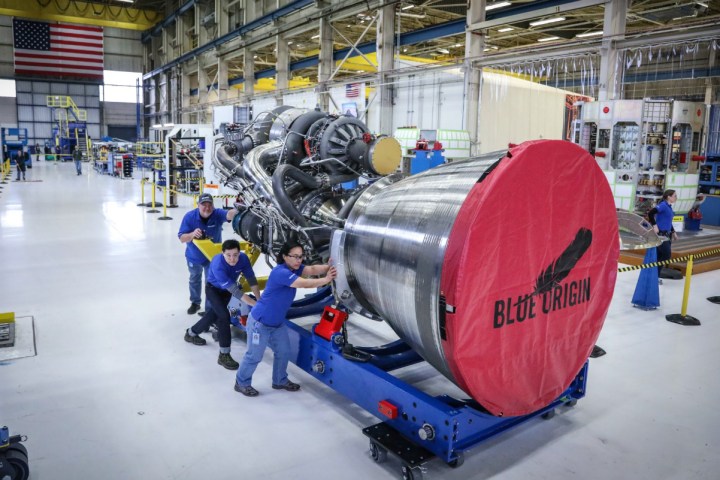
Keen to let everyone know his space team also wants to go to the moon, as well as other places far beyond, Bezos this week tweeted a couple of photos of a gleaming new rocket engine.
The images show Blue Origin’s very first BE-4 booster, the rocket engine that it claims will end American dependence on Russian engines by 2019.
1st BE-4 engine fully assembled. 2nd and 3rd following close behind. #GradatimFerociter pic.twitter.com/duE4Tnzvkx
— Jeff Bezos (@JeffBezos) March 6, 2017
Two additional BE-4 engines are currently in production, Bezos added on Twitter.
Fully paid for by the private sector, seven of the BE-4 engines will be used to power the first stage of Blue Origin’s awesome New Glenn reusable rocket, which is currently under development.
The new rocket engine could one day play a part in taking astronauts on missions to the moon. Indeed, news surfaced just last week that Bezos is keen to launch “an Amazon-like shipment service” to the lunar surface.
No, such a service wouldn’t be viable today, as there’s no one there just now. But in the future, there could be a community of scientists stationed there for research purposes, or perhaps a small “tourist resort” for people who are cool with really long-haul travel.
“It is time for America to return to the moon — this time to stay,” Bezos wrote recently in an email to the Washington Post. “A permanently inhabited lunar settlement is a difficult and worthy objective. I sense a lot of people are excited about this.”
Bezos’s proposal, which was sent to NASA as well as top members of the United States government, focuses first on transporting cargo and other important gear for setting up a colony — possibly starting in the mid-2020s — with humans arriving on the planet some time (perhaps a long time) later.
The Amazon founder and CEO said the ambitious project could only happen in partnership with NASA, adding, “Our liquid hydrogen expertise and experience with precision vertical landing offer the fastest path to a lunar lander mission. I’m excited about this and am ready to invest my own money alongside NASA to make it happen.”
Anyway, all that’s far in the future. First up are tests for the BE-4 rocket, and if they all go swimmingly, the booster should one day help to transport astronauts to the International Space Station in low-Earth orbit, or whatever inhabited satellite replaces it in the coming years.
Editors' Recommendations
- Blue Origin’s heavy-lift New Glenn rocket raised on launchpad for first time
- See how Blue Origin’s rocket did in first flight since 2022 explosion
- Jeff Bezos’ Blue Origin to make first rocket flight since 2022 explosion
- Blue Origin wants to launch rockets from new site outside U.S.
- Jeff Bezos’ Blue Origin finally gets coveted moon contract


